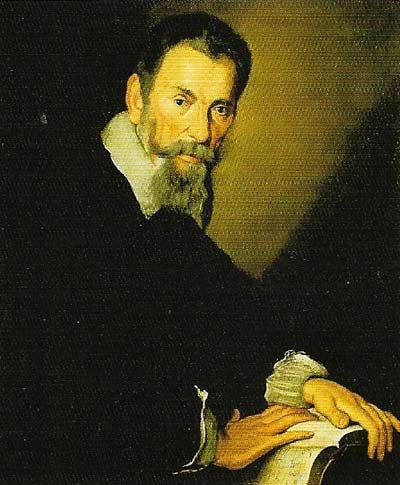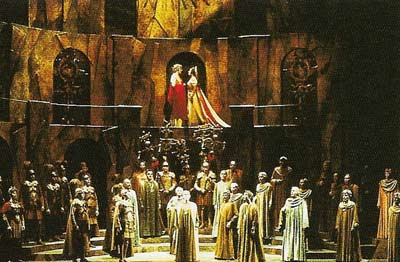Monteverdi, Claudio (1567–1643)

Claudio Monteverde, painted around 1640 by Bernardo Strozzi.

A scene from a 1975 production of L'incoronazione di Poppea (1642), shortly after its re-introduction to modern audiences.
Monteverdi was a composer of enormous significance in the history of music. Like his contemporary Heinrich Schütz in Germany, he bridged the worlds of the High Renaissance and the Baroque era. He can also be compared to Stravinsky: during the course of long lives both men showed an endless capacity to re-invent and adapt their musical styles according to changing tastes.
Early years
Monteverdi began his career as a chorister at the cathedral in his birthplace, Cremona. By the age of 16 – already a fine instrumentalist — he had published a volume of three-part motets and a book of sacred madrigals. In 1587 he published his first volume of secular madrigals, followed by a second volume in 1590. Around that time he found a job as a string player at the ducal court in Mantua, and by the time his third madrigal collection appeared in 1592 his fame as a composer was spreading rapidly. He married in 1599 and had three children, of whom two sons survived: the elder became a musician, the younger a doctor.
Triumph and tragedy
In 1601 Monteverdi became maestro di cappella at the Mantuan court, where he published two more madrigal collections over the next four years. In 1607 he made his first foray into the new genre of opera with L'Orfeo, which was performed in Mantua in February. Seven months later his wife died after a long illness, leaving Monteverdi a grief-stricken widower with two small children.
He was obliged to pull himself together enough to finish his second opera, L'Arianna, which was performed in May 1608 to celebrate the marriage of the Gonzaga heir, Francesco, to Margaret of Savoy. (Only one aria from this opera has survived.) During rehearsals another tragedy struck when Caterina Martinelli, the young principal singer and a close friend of Monteverdi, died of smallpox. Monteverdi then suffered a complete collapse, although his glorious setting for voices and instruments of the Vespro della beata vergine (Vespers of the Blessed Virgin, 1610) dates from this unhappy period.
Venice
After making several attempts to leave the service of the Gonzagas, Monteverdi was finally dismissed in 1612, and in 1613 became maestro di cappella at St Mark's Cathedral in Venice, where he remained for the rest of his life. He also continued to write ballets and operas for the Mantuan court, but many of his scores were destroyed when Austrian troops sacked the palace in 1630. In the same year Venice was ravaged by plague, and shortly afterwards Monteverdi renounced the world and took holy orders.
In 1637, after the first public opera house opened in Venice, he was commissioned to write several operas. The two that survive – Il ritorno d'Ulisse in patria (The Return of Ulysses) and L'incoronazione di Poppea (The Coronation of Poppea) – are masterpieces of the genre in their superb characterization and instinctive feel for dramatic effect. The final scene of L'incoronazione di Poppea, despite celebrating the union of two ambitious and deeply unpleasant people, contains one of the most intensely passionate love duets in all opera.
The works of Monteverdi's Venetian years include three more madrigal collections. Book 8 of 1638, entitled Madrigali guerrieri et amorosi (Songs of War and Love), contains substantial dramatic works such as II ballo delle ingrate, and the famous Combattimento di Tancredi e Clorinda, a graphic description of a duel between the Christian knight Tancred and the pagan Clorinda, who is disguised as a man. As a whole, the madrigal collections show Monteverdi moving with the times, from typically Renaissance polyphonic pieces in the earlier volumes (one of the most beautiful and frequently performed of these is the five-voice Zefiro torna, a setting of words by Petrarch), to highly expressive dramatic works for solo voices with instrumental accompaniment in the later ones. All his music, early or late, is characterized by qualities of emotional intensity, depth of expression, and understanding of human nature comparable with those that inform the works of Shakespeare.
Major works
Nine books of madrigals; Vespro della beata vergine (1610); La favola d'Orfeo (1607); Il ritorno d'Ulisse in patria (1640); L'incoronazione di Poppea (1642).


